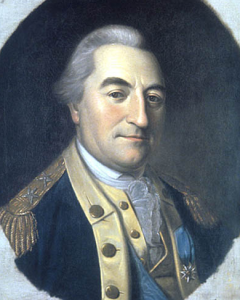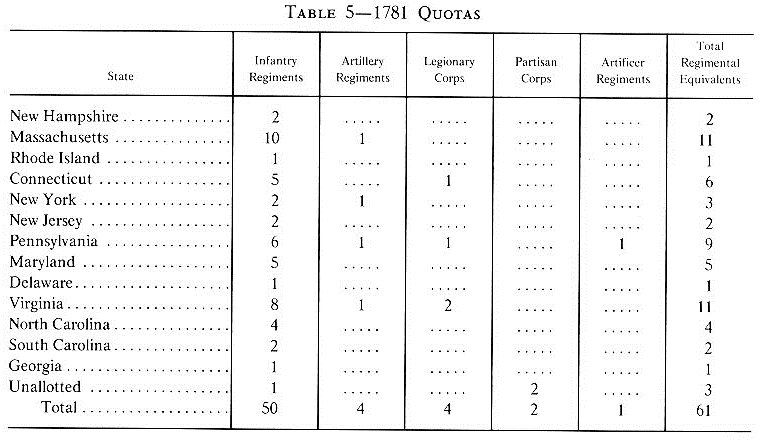Perseverance to Victory
The first two years of the War of American Independence witnessed the growth of the Continental Army from a nucleus of New England and New York units patterned after the Provincials of earlier wars into a force with men from every state as well as foreign volunteers. Through those volunteers, particularly Steuben and Duportail, European military theory and training merged with practical American experience. Beginning at Valley Forge this blend led to a relatively sophisticated organization that was sufficient to meet most of the battlefield problems faced by the Continental Army. During the final years of the Revolution a growing shortage of men and the general collapse of the American economy forced retrenchment. In time the Continental Army disappeared as a standing military force, but not before its triumph at Yorktown. When it disbanded, moreover, it did so in an orderly manner that reinforced the political stability of the new nation.
The concern of the 27 May 1778 congressional reorganization to reduce expenses and adjust quotas to a realistic level became more acute in succeeding years. As British operations shifted emphasis to Virginia and states farther south, Washington and Congress transferred large elements of the Main Army to the Southern Department. By October 1780, when the three-year enlistments of 1777 were about to expire, the need to realign the existing military organization became intense. The major reorganization that resulted attempted to deal realistically with the limitations while still extracting maximum utility from the available resources.
Washington, Congress, and the Board of War wrestled throughout the winter of 1778-79 with the fact that the Continental Army had not achieved the strength set for it in 1778. Congress had no power to enact the national draft that Washington desired, although it did recommend that the individual states consider using a draft to meet their quotas. On the other hand, Washington and Steuben had to persuade Congress not to undertake a major reorganization of the Infantry. The next winter a similar issue arose when some delegates sought a reduction in the number of regiments in the hope of obtaining a more efficient force of full units. Washington again recommended avoiding a large-scale reorganization for the time being, arguing now that he could not undertake a major offensive until he received French naval and economic aid. He expressed particular concern over the impact that a reduction would have on the officer corps, but he also pointed out deficiencies in the 27 May 1778 reorganization. On the basis of Steuben’s report that a minimum rank and file strength of 324 men per regiment was needed for anticipated operations (allowing 36 men each
for the 1 light and 8 line companies), Congress on 9 February 1780 decided to establish quotas to place 35,211 men in the field for the coming campaign. No regiments were disbanded. Of this force, aside from supporting troops, the Infantry was to have a combat strength of 21,000; the Artillery, 2,000; and the Cavalry, 1,000.1
In January 1780 the Continental Army actually contained approximately that number of officers and men.2 The Southern Department included all the troops from Georgia and the Carolinas, the three provisional Virginia regiments, two regiments of dragoons, and Pulaski’s legion. The equivalent of a brigade of continentals served in the Eastern Department, while the Northern and Western Departments each had two regiments. Sixteen brigades plus supporting troops, the heart of the Continental Army’s fighting strength, remained either with the Main Army or in the Highlands Department. Excluding the New Hampshire Brigade at Danbury, Connecticut, the fifteen brigades in New Jersey and the Highlands included an Infantry contingent of 168 field, 1,209 company, and 273 staff officers; 1,650 sergeants; 1,579 drummers and fifers; and 14,673 rank and file. The Artillery had 180 officers and 1,190 enlisted men; the Cavalry, another 64 officers and 672 men. The brigades were short 331 officers, 315 sergeants, 242 drummers and fifers, and 13,353 rank and file.
In the spring of 1780 Washington began to consider an attack on New York City if he could obtain the assistance of a French expeditionary force under Lt. Gen. Jean, Comte de Rochambeau. Efforts began to increase the effective strength of the Main Army, but when Rochambeau’s troops arrived at Newport, Rhode Island, too debilitated from the sea voyage for action that year, Washington reluctantly had to abandon his plans. In September the Main Army, the Highlands Department, the Northern Department, and the Eastern Department contained a dozen Continental brigades plus supporting units and a number of regiments in detached garrisons. The Continental Infantry now included 169 field, 1,091 company, and 261 staff officers; 1,381 sergeants; 774 drummers and fifers; and 17,232 rank and file. Artillerymen from three regiments totaled another 140 officers and 1,097 men, while the Cavalry contingent numbered somewhat more than 500 of all ranks. Militia reinforcements in New York and Rhode Island amounted to 181 officers and 3,192 men.3 There were acute shortages, particularly among ensigns, Artillery second lieutenants, and enlisted men. The Infantry force lacked 372 officers, 384 sergeants, 340 drummers and fifers, and 12,718 rank and file; the Artillery regiments, 77 officers and 652 men. Equally significant, over 200 Infantry officers were performing staff duties.
Routine recruiting problems represented only one part of the Main Army’s strength problem. The deteriorating military situation in the Southern Department had robbed Washington of a substantial number of veteran regiments. To counter Britain’s offensive against the southern states, Congress had ordered reinforcements sent to Charleston. Both of Washington’s North Carolina regiments arrived there on 3 March 1780, joining the reorganized 3d North Carolina Regiment. The Virginia line (less the regi-
1. JCC, 15:1357-59, 1369, 1376-77, 1393-96; 16:36-38, 80-83, 110, 117-20, 123, 125-28, 146-51, 17880, 287; Fitzpatrick, Writings, 16:78-79; 17:172, 407-8, 431-36, 504-6; 18:202-4, 207-11; Burnett, Letters, 5:33, 92-93; Steuben Papers (undated 1780 memorandum).
2. RG 93, National Archives (Monthly Return, Main Army, January 1780); Lesser, Sinews, pp. 148-50, prints a variant of this return.
3. RG 93, National Archives (Monthly Return, Main Army, September 1780); Lesser, Sinews, pp. 180-82, prints a variant of this return.

ment at Fort Pitt) under Brig. Gen. William Woodford reached Charleston on 6 April 1780. The 1st, 2d, and 3d Virginia Regiments were at full strength while the other regiments had officer cadres only. Woodford’s force then joined with the first two of the provisional Virginia regiments ordered raised in 1779.4 These North Carolina and Virginia units and the Georgia and South Carolina remnants surrendered on 12 May 1780 when Charleston fell. This defeat was the worst suffered by the Continental Army during the Revolution. The sustained (42-day) defense of an inferior position, however, did demonstrate the increased fighting ability of the Army. Through the sophisticated use of artillery cross fire and ricochet techniques the Americans kept the British at bay until jaeger sniper fire silenced the guns.5
On 5 April 1780 the Maryland division, which included the Delaware Regiment, and the 1st Continental Artillery Regiment had received orders to transfer to the Southern Department. General de Kalb, the commander of these troops moving south, provisionally reorganized them on 15 July while en route. When Charleston fell, his became the only significant combat force in the south. De Kalb formed a division of four full eight-company regiments and sent the surplus officers home to recruit. On 24 July General Gates assumed command of the Southern Department.6 After militia reinforcements arrived, Gates met a crushing defeat at Camden, South Carolina, on 16 August, but de Kalb’s continentals fought well. The survivors of his division reas-
4. JCC, 15:1087, 1256, 1347; Burnett, Letters, 4:322-23, 419-20, 428-29; Fitzpatrick, Writings, 16:360, 382, 473; 17:124, 134-35, 151, 175, 206-8, 228, 236-38, 242-43, 309; Moultrie, Memoirs of the American Revolution, 2:67, 114. For the provisional Virginia regiments, see above, Chapter 6.
5. Kite, Duportail, pp. 172-75; Bernard A. Uhlendorf, ed., The Siege of Charleston (Ann Arbor: University of Michigan Press, 1938); Heinrichs, “Extracts From the Letter-Book,” Pennsylvania Magazine of History and Biography, 22: 137-70.
6. JCC, 16:329, 17:508; Fitzpatrick, Writings, 17:228-29; 18:198-99, 204, 269; 19:78-79; Gates Papers (de Kalb to Bd of War, copy, 6 Jun 80; de Kalb to Gates, 16 Jul 80; Bd of War to Gates, 15 Jun 80; Gates to Richard Caswell, 25 Jul 80; de Kalb’s division orders, 15 Jul 80; Return, 22 Jul 80).
sembled quickly, thanks to their superior training, as a provisional regiment composed of two four-company battalions and two light infantry companies.7
Washington’s efforts to procure replacements to offset the transfer of his Virginia, Maryland, and Delaware regiments were facilitated by the prospect of a Franco-American attack on New York City and by a special congressional committee which visited headquarters in late spring. The primary mission of the committee was to investigate the logistical system, which was tottering on the brink of collapse because of rampant inflation and other problems in the American economy, and to prepare recommendations for reform. Congress especially wanted to trim expenses. The committee’s secondary mission was to identify surplus regiments and to recommend revised regimental structures to achieve further savings. The committee members—Philip Schuyler, John Mathews, and Nathaniel Peabody—interpreted their mandate broadly and supported Washington’s preparations for the planned operation. When Washington canceled the attack in late June, the committee returned to its basic task; the recommendations it submitted to Congress would form the basis for reforms in the various support departments in the fall.8
By October 1780 the Continental Army had received a series of major blows: the fall of Charleston, the debacle at Camden, and the terrible shock of Benedict Arnold’s treason. The economy still verged on the brink of total collapse, and the three-year enlistments of 1777 would expire during the coming winter. As early as 15 September Washington had recommended to Congress that it centralize all military affairs under itself and resort to three-year drafts. He argued that maintaining a strong Continental Army would cost less than constantly calling out the militia, and he reminded the delegates that
no Militia will ever acquire the habits necessary to resist a regular force. Even those nearest the seat of War are only valuable as light Troops to be scattered in the woods and plague rather than do serious injury to the Enemy. The firmness requisite for the real business of fighting is only to be attained by a constant course of discipline and service.9
On 28 August Congress had anticipated his needs by appointing a five-man committee to prepare a reorganization plan. In addition to Samuel Adams, the committee included four staunch supporters of Washington: Joseph Jones of Virginia, Thomas McKean of Delaware, John Morin Scott of New York, and Ezekiel Cornell of Rhode Island. They consulted with Steuben and then recommended that Congress require each state to have a full complement of men in the field by 1 December. If a state could not fill its quota with men enlisted for the duration of the war, it was to furnish the balance, whether volunteers or draftees, for a period of not less than one year. The key innovation was the stipulation that the drafted men had to serve until replacements arrived. Congress adopted this plan on 21 September. Changing strategic needs, however, never allowed a thorough test of this system.10
7. Steuben Papers (Otho Williams to Steuben, 12 Oct 80; Mordecai Gist to Steuben, 12 Oct 80; Return, 1 Oct 80); Gates Papers (to Washington, 3 Sep 80; Return, 23 Sep 80). The defeat caused Maryland to abandon efforts to organize an eighth regiment, the “Regiment Extraordinary.”
8. JCC, 16:75-79, 293-312, 332-33, 350-57, 362; 17:472, 522-23, 528, 579-80, 589-90, 604-5, 607-8, 719-20; 18:878-88, 1109-11; Fitzpatrick, Writings, 18:207-11, 356-58, 416-19, 425-32, 455-59; 19:2,7785,118,391-94; Burnett, Letters, 5:80, 89-92, 114, 126-78, 222, 343,372-74.
9. Fitzpatrick, Writings, 20:50; see also 19:402-13, 481-82. For an account of the logistical problems at this point, see Erna Risch, Supplying Washington’s Army (Washington Government Printing Office, 1981).
10. JCC, 17:786; 18:839,844; Burnett, Letters, 5:378-79,389-90. A similar system had been proposed by the Board of war in February, but Congress had declined to act on it. JCC, 16:248-51.

On 3 October 1780 congress gave preliminary approval to a comprehensive reorganization plan which attempted to balance financial constraints and Washington’s wishes. As James Duane told the Commander in Chief, the plan was “submitted, as it is, to your Opinion. It is only to be considered as an Essay open to such Alterations as you may suggest.” On 21 October Congress adopted verbatim the changes Washington had requested.11
The final plan specified that on 1 January 1781 “the regular army of the United States” was to consist of 49 infantry regiments, Moses Hazen’s special Canadian infantry regiment, 4 artillery regiments, 4 legionary corps, 2 partisan corps, and a regiment of artificers. Although not mentioned in the legislation, the Corps of Engineers, the companies of sappers and miners, the Marechaussee, and the Corps of Invalids remained unchanged. All other units had to disband and transfer their enlisted men to the line regiments. Congress allotted every regiment, except Hazen’s and the two partisan corps, to a single state (Table 5) to simplify subsistence and troop replacement. At Washington’s request, it gave the Army rather than the state governments the power to decide which officers were to retire. Seniority would be the determining factor in resolving disputes.
The heart of the reorganization was the realignment of the Infantry. Congress apportioned the forty-nine regiments on the basis of realistic estimates of the men available in each state, rather than total population. A fiftieth regiment, Hazen’s unallotted regiment, which now became the Canadian Regiment, continued under its four-battalion configuration. It absorbed the remaining Canadians from James Livingston’s old 1st Canadian Regiment plus various other men.12 Washington did not object to the total number of infantry regiments, but he doubted that every regiment would achieve full strength. He also complained that the three regiments allotted to South Caro-
11. JCC, 18:893-97, 959-62; Burnett, Letters, 5:404, 407, 414-15 (Duane quotation), 417-18, 422-23, 428; Steuben Papers (to Washington 23 Oct 80); Fitzpatrick, Writings, 20:157-67, 263-64, 277-81, 311-12, 400.
12. JCC, 19:427-28; 20:711-12; RG 93 National Archives (Bd of War report, 28 Jun 81).

lina and Georgia would have to be excluded since those states were occupied by the enemy. The plan would then provide for only 18,000 infantrymen. Washington said he needed 22,000: 18,000 for mobile field forces, 2,500 for garrisons in the Hudson Highlands, and 1,500 for service on the frontiers.
The congressional plan continued the basic regimental alignment of one light and eight line companies, all equal in size. It added three enlisted men to each company and left the number of officers unchanged. Washington, however, persuaded Congress to make substantial alterations. (Chart 11) Each regiment’s three field officers—colonel, lieutenant colonel, and major, or lieutenant-colonel commandant and two majors—now no longer served as company commanders. This change enlarged the pool of field-grade officers for special assignments and significantly increased the number of captains within each regiment. Every company could expect to have three officers present in combat. Two additional sergeants, one for the first time officially designated the first sergeant, and another corporal joined each company. The number of privates in a regiment [i.e., company] increased from fifty-three to sixty-four. Four extra lieutenants joined the staff to fill the permanent positions of paymaster, adjutant, quartermaster, and recruiter. The regimental recruiter remained in his home state with a drummer and a fifer and worked full time to secure replacements. Extra lieutenants were available because of the reduced number of regiments; they also filled positions left vacant by the shortage of ensigns.
